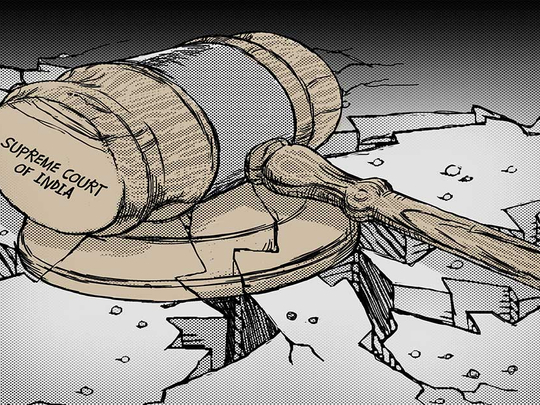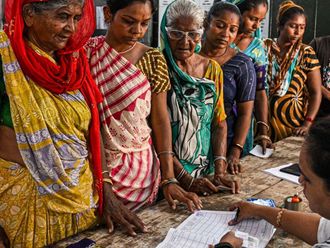
At 10.30am, on January 12, 2018, the bailiffs went through their routine in India’s Supreme Court, shouting “All rise” and there was nothing to suggest something extraordinary was about to happen. But precisely at 11.20am, four of the senior-most judges of the apex court abruptly rose from their respective benches and hurried out of the court and this set off shock waves around the country.
Wild rumours spread immediately. Fortunately, these speculations were quickly laid to rest when they held an impromptu press conference in Justice Chelameswar’s residence. Sadly, however, the tremors from that astonishing press conference are yet to subside. The aftershocks from within the court’s crust continue to reverberate to this day.
For, what happened at that presser was totally unprecedented in the history of India’s Supreme Court. Never before had the country witnessed four of the court’s senior-most judges — Justice Chelameswar being one of them — in open revolt against the Chief Justice of India (CJI), Justice Dipak Misra.
A mutiny with no parallel; for though these judges raised procedural issues for the rebellion, there were ominous hints dropped to indicate that something was seriously wrong in the state of India: The crown jewels of the republic, the hallowed Constitution and its guardian the Supreme Court were under siege; a precipitous loss of lustre for the court and from within, too, and this simply beggared belief.
Screaming headlines characterised this as the worst constitutional crisis in India’s history. Worse than what had happened in 1976, when an internal emergency was announced and the then chief justice, A.N. Ray, capitulated to the then prime minister, Indira Gandhi’s, diktat and meekly surrendered the independence of the judiciary.
Democracy indeed had been derailed, it was India’s darkest hour. Yet, even at this low point in India’s history, corruption was not hinted at. It was alleged that the loaves of office impelled Justice Ray to submit to Indira; he had superseded three other senior judges to be elevated to the high office of Chief Justice. Justice Mohammad Hidayatullah (who was CJI earlier) remarked that “this was an attempt at creating ‘forward-looking judges’... Judges looking forward to the plumes of the office of Chief Justice”.
The reputation of the Court had been tarnished, but there was no revolt and no charge of systemic corruption against the higher judiciary, as is the case now. Ideological differences within the Court were cited for that one-time aberration for there was the thinking then that a committed judiciary and bureaucracy was the need of the hour to keep the barbarians at the gate. That line was false on many counts.
Nevertheless, filthy lucre was never hinted at, at least not as brazenly as is being alleged now. It is being alleged now that corruption has reached the very gates of this Supreme Court, with specific names being bandied about — a marked difference from earlier times. The sacred temple of justice was being vandalised. Concomitantly, the charge of shopping for benches at the apex court for getting a favourable verdict is an open secret. Defendants are being routinely advised by senior advocates to file appeals after ascertaining which bench is likely to get them a more sympathetic hearing of their case.
The first trigger
The medical admission scam that hit the national headline in September in 2017 is one of the triggers for this crisis. The CBI arrest of IM Quddusi, a retired judge with the Orissa High Court between 2004 and 2010, and the five others was the tip of the iceberg. This strange cabal of a retired judge and his accomplices offered to fix the ban imposed on Prasad Institute of Medical Sciences (PIMS) of Lucknow, a private medical college, for a price.
The government had earlier banned the institute from enrolling students as their teaching facilities were found to be substandard, but just after that injunction, it was alleged that Judge Quddusi and his fixers approached the institute and assured them that the ban could be revoked if large sums of money were paid to senior functionaries of the apex court. On the back of this assurance, PIMS challenged the government in the Supreme Court.
Curiously, just before the case could move further, Quddusi advised the petitioners to withdraw the case and instead proposed moving the Allahabad High Court, possibly hoping to get a quick respite from that High Court, even if it be temporary. This yielded results, for the Court issued a disbarment order that gave interim relief to the petitioner.
Once this relief was secured, PIMS quickly reinstated its write petition in the Supreme Court and it is at this stage that the Central Bureau of Investigation nabbed the culprits and impounded the payout — Dh400,000 — to influence peddlers. The CBI immediately slapped a criminal conspiracy charge against the judge and his accomplices and to make matters worse, incriminating telephone transcripts were discovered and made public. These transcripts clearly pointed the finger of suspicion at the highest echelon of the judiciary.
The Campaign for Judicial Accountability and Reforms (CJAR is a group of lawyers in India who work to improve the accountability of judges) has filed a petition in the Supreme Court, seeking an independent probe headed by a retired CJI. The petitioner, Kamini Jaiswal, contended that such a probe was urgently needed as it involved charges of corruption in the highest judicial bodies — the high courts and the Supreme Court.
The petition was put up before the bench of Justice Chelameswar who admitted the petition and ordered the setting up a constitution bench of the five senior most judges for hearing the case. The petitioners also insisted that Chief Justice Misra should not be on the constitution bench as he was on the original bench that dispensed with the case relating to Prasad Education Trust, the owners of PIMS.
Before Justice Chelameswar’s constitution bench could be formed, the CJI quickly stepped in and annulled this order and instead formed a new bench under him to look into this case. The master of rolls, an administrative function that is the preserve of the CJI, permits him to do this and he chose to exercise this right.
The second trigger
The actual tinder box for this flareup is however wrapped in an extremely controversial case that is as fanciful as a crime thriller. In 2012, the Supreme Court had ordered an investigation into as many as 22 alleged extrajudicial killings in Gujarat between 2003 and 2006. Among them was the Sohrabuddin Shaikh fake encounter case which, in 2010, had led to the resignation and arrest of the then Gujarat minister Amit Shah (now the president of the Bharatiya Janata Party.)
Thereafter, the Supreme Court stepped in and in 2014 tasked a CBI Court headed by Judge Brijgopal Harkishan Loya to examine this case. But before Judge Loya could deliver his judgement, he died and the judge who replaced the deceased gave Shah a clean chit. There was a lull after this, but just after the Gujarat state elections were announced in November 2017, Caravan magazine began exhuming this case on the pretext that a deep-seated conspiracy existed and made sensational claims — that Judge Loya’s death was not natural and that he was offered a Rs100 crore bribe for a favourable verdict.
Next, well-known columnist Tehseen Poonawalla, with links to the Congress party, asked his lawyer Dushant Dave to file a plea in the Supreme Court for an independent probe into the mysterious death of Judge Loya. Into this explosive cauldron comes the curious incident of two Senior Supreme Court advocates — Dushant Dave, the petitioner’s lawyer, and Indira Jaisingh, both part of CJAR — making an earnest plea to Justice Misra to recuse himself from this case. Justice Misra declined this plea and what followed was even curiouser.
The narrative gathers pace now, Dushant Dave writes a column alleging Justice Misra to be a BJP sympathiser and within minutes of Justice Misra posting the case for January 16, 2018, the four judges hold their press conference and finally in a bizarre twist there is a fallout between senior counsel Dave and petitioner Poonawalla.
Since then, sanity has prevailed. Justice Misra has recused himself from the case and CJI has formed a new bench to hear the case and agreed to a more transparent process of assigning cases to different benches without in any way diluting his inherent rights as master of rolls. But as we discuss this case, the hearings are going on in Court and the tidbits of the court proceedings that are dribbling out are not particularly edifying.
India will be on the razor’s edge if the verdict goes against Shah. The prime minister will be cut adrift. And the cynic will retort, at least the Supreme Court regained its lustre.
Ravi Menon is a Dubai-based writer, working on a series of essays on India and on a public service initiative called India Talks.









